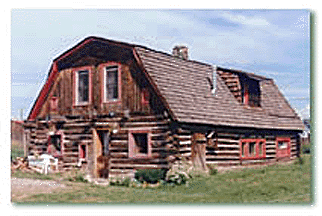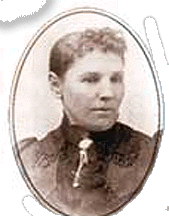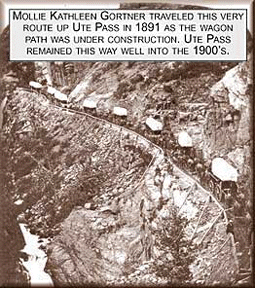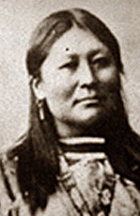 |
| Doc Susie's home from: Ellensplace.com |
When gold and silver were discovered in the mid and late 1800¹s in the West, most women were forced to go along with their husbands to the mining fields. But sometimes they went because they liked the idea of being in the wilderness and supporting themselves.
Some women washed the filthy clothes of grubby miners (although some men wore their clothes until they rotted off!), or else ran boarding houses or stores, called ³mercantiles² then. Most women thought walking around in icy water to find gold or burying themselves like trolls in mines was men¹s business. But a few women were infected with the urge to dig for gold and silver.
Caroline Morehouse Mallen was born in 1829 in Ohio, and she lived a mysterious life. She was left widowed with two children after being married for two years. During her time in central Colorado, near Buena Vista, she was a well-respected prospector, and fifteen mining claims are recorded in her name. Her territory covered a tremendous area, including dangerous avalanche areas above 12,000 feet.
What a vigorous woman Caroline Mallen must have been! She had to haul water a mile, and bring food and supplies up from town to her cabin, which was over 9,000 feet in the mountains, and she drilled, blasted, and shored up her mines with timbers by herself. She also had to haul out her own ore and wastes.
Curiously enough, she talked to spirits, who told her where to dig and also warned her to break off her engagement to the Russian Czar! That was a story that existed only in her own head.
But she seems to have been a shrewd business woman, and she grew rich. Eventually, Caroline Mallen settled down in Buena Vista, where she built her own house and lived until she died in 1902.
When Olga Schaaf was only 14, she was breaking horses and earning $5 a week, good money in the late 1800¹s. When she was 26, she met a mine owner in southwest Colorado who was desperate for someone to take a pack train of burros up in the high mountains to his various miners, who had no other way to get food and supplies in the winter. Trails were covered with over ten feet of snow and bridges and rivers frequently were washed out. Soon Olga was making $300 a month. She became famous and was totally dependable, coming through with supplies in any weather over hazardous routes. She loved her animals, and soon had 35 in a pack train. Once three burros fell while carrying dynamite, and one time her leg was broken when her horse slipped and fell on her.
One time Olga was stranded at a mine by a big snowstorm. Soon no food was left, but she managed to get all the miners and burros down the mountain because she knew where the trails were buried under the snow. She didn't stop carrying supplies to miners until the 1940's, and she died in 1970.
 |
| Mollie Gortner from: Gold Mine Tours.com |
Mollie Kathleen Gortner came to the Cripple Creek, Colorado, mining camp in 1891. She was only visiting her son and wasn't planning to be a gold miner. But one day she went into Poverty Gulch to see a herd of elk her son had told her was there. When she stopped to rest a minute, she saw some rocks that looked like the kind he had told her might hold gold. She didn't want any of the other miners to see what she'd found, so she hid the rocks in her clothes and went back to town.
Her excited son staked a claim for her and she took the survey description down to the local Claims Office. The manager said she couldn¹t file a claim because she was a woman. She snatched the file papers back and signed them, becoming the first woman ever to file a claim in her own name. Her gold mine became famous as The Mollie Kathleen Mine.
 |
| The path Mollie Gortner traveled. From: Gold Mine Tours.com |
Anne Ellis lived in Bonanza, in the Rocky Mountains of central Colorado. The mining there lasted from 1880 to the 1930s. It was a pretty wild town, with over five thousand people and many saloons, like all mining towns. Life in Anne's very poor family was full of hardships and dangers for a growing girl. Women would borrow yesterday's soup bones from friends to make soup for their children when times were hard. Furniture might include only part of an old dresser. Children died early, and so did mothers. Fathers were killed in mining accidents.
The Ellis family had come across the country in a covered wagon to find gold. But her father, who was charming but hated to work, found the mines too tough, so he ran off and left his wife with two babies.
Anne Ellis wrote The Life of an Ordinary Woman, but she certainly wasn't an ordinary woman or and ordinary writer. She wrote about the good people in the town, the neighbors who helped each other and the women who made do. Later, she wrote that "the buildings in Bonanza were so stooped and gray with age that they lean on each other for support; the windows are all broken like blind eyes; and the sidewalks so torn and warped that they look like twisted hands." This book is full of what she called "memory pictures" of how things where, the good and the bad.
She educated herself by reading whatever books she could find, including classics from the Denver traveling library. Her one true love left because of misunderstanding, so she learned how to teach school, and she ran a boarding house for miners. Later she became the first telephone operator in Bonanza.The first time she married, she lost that husband in a mine accident. With another husband she went to the mines in Goldfield, Nevada, but she always came back to Bonanza.
Writing about all her troubles, including the dreadful loss of her nine-year-old from diphtheria, Anne Ellis was a woman who not only persevered through a difficult, painful life, but one who always looked on the good side of things.
 |
| Doc Susie from: Ellensplace.com |
Doctor Susan Anderson, known as Doc Susie, went to Colorado from Fort Wayne, Indiana, in 1897. She'd been told during medical school that she had tuberculosis (then called consumption), and that she should go to the mountains for her health. She went to Cripple Creek and practiced medicine, but moved on to Denver and then Greeley, because women doctors weren't easily accepted in those days. Her tuberculosis became worse, so she headed for Fraser, Colorado, in the high mountains.
She didn't tell anyone she was a doctor at first, and her first patient was a horse. Soon people realized she was a real doctor, and she had many patients, and she would go in the worst winter weather to treat patients in remote logging camps. Doc Susie became the Coroner for Grand County, and she wasn't afraid to tell the commission responsible for building a new railroad tunnel how hazardous the workers' conditions were.
Dr. Susan Anderson was the only doctor in Frazer until 1956. She died in Denver in 1960, and she was recently inducted into the Colorado Women's Hall of Fame.
 |
| Chipeta from:Museum Trail.com |
Chipeta, wife of Ute Chief Ouray, was almost hanged by a lynch mob in Alamosa, Colorado, in 1880. She and a number of Ute chiefs had come there to take a train to Washington, D.C. to speak to the government about reservation resettlement issues.
Chipeta was born in 1843, and married the Ute chief in 1859, when she was sixteen. Ouray had been friendly with whites, most of whom at that time wanted to get rid of all the natives and have the land to themselves. The Utes had been moved onto a reservation that included the San Juan Mountains and the Animas River area, in what is now southern Colorado, but when large silver and gold deposits were found, miners wanted them moved to a reservation in Oklahoma.
Ouray and Chipeta both knew more white settlers would come, and they wanted to show the newcomers how both whites and natives could live together peacefully. But so many treaties had been broken that it was impossible for the tribe to retain their ancestral lands. Many of them ended up in western Colorado and Utah.
After Chief Ouray died in 1880, Chipeta kept on working for better relations between Utes and whites. She was a beautiful woman, with a kind and gentle manner, and she became famous for her work. Chipeta died in 1925 and is buried near Montrose in western Colorado.
Page created on 7/3/2004 12:00:00 AM
Last edited 1/9/2017 6:31:25 PM
She and another missionary wife, Narcissa Prentiss Whitman, had to ride side-saddles for nearly 2,000 miles. No Oregon or California Trail existed in 1836, and the two women and their husbands traveled with traders on their way to a Rendezvous with fur trappers in the Rockies. From there on, the missionaries traveled with British traders from the Hudson¹s Bay Company in Vancouver.
Eliza Hart Spalding lived for eleven years in a primitive mission in what is now northern Idaho near Lewiston. She lost several children to miscarriages, and almost died on her journey west because of poor health and her inability to eat fresh buffalo meat, their only food for some weeks. In 1847 her oldest daughter, also called Eliza, was a witness to the massacre of the Whitmans and eleven other whites at the Whitman mission, near present-day Walla Walla, where she was attending school. Held hostage by the Cayuses as an interpreter for a month, the girl was eventually reunited with her parents.
Only the Nez Perce people¹s love for Eliza Hart Spalding kept her and her family from also being massacred. She persevered in bringing the word of God to the tribe until forced to leave her mission. She died of tuberculosis several years later in a town in Oregon.
